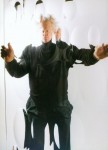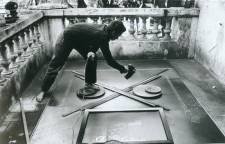

Rogelio Polesello
Argentine, 1939-
Multiplier, 1971
plexiglas, lightbox, wood, electrical cord
78 5/8 x 39 x 3/4 in.
SBMA, Gift of Robert B. and Mercedes H. Eichholz
1995.50.4

Polesello holding one of his art works, 2005

Polesello spray painting on the terrace of his Buenos Aires studio, 1965 Photograph: Cornel Capa / Magnum
COMMENTS
Rogelio Polesello was born in Buenos Aires, July 26, 1939. He studied at the Escuela Nacional de Bellas Artes Manuel Belgrano and graduated from the Escuela de Artes Visuales Prilidiano Pueyrredón as a professor of print, drawing and illustration in 1958.
Influenced by the Uruguayan artist Torres-García and the Argentinean Pettoruti, Polesello has taken the Constructivist tradition in Latin America, with its search for order through geometric abstraction, to a new level, defining geometry in human terms in his work that is both full of vitality and sensual interaction.
He has had numerous individual exhibitions in major galleries and museums in Latin America, Europe and the United States and his work is part of the permanent collections of the Museum of Modern Art in New York, the Solomon R. Guggenheim Museum in New York, and the Museum of Modern Art of Latin America in Washington D.C., among others.
http://www.rogallery.com/Polesello_Rogelio/Polesello-bio.htm
Rogelio Polesello studied at the Escuela Nacional de Bellas Artes Manuel Belgrano and the Escuela Nacional de Bellas Artes Prilidiano Pueyrredon, both in Buenos Aires. In 1959, he joined the Asociacion Arte Nuevo, founded by Aldo Pellegrini and Carmelo Arden Quin. The paintings he included in his first solo exhibition at the Galeria Peuser (Buenos Aires, 1959) followed the aesthetics of Op Art and were based on Gestalt theories. Their geometric forms, generally in black and white, added to or subtracted from the whole according to perceptive principles that produced specific optical effects.
Around 1962, Polesello briefly joined the group Boa, whose members followed neo-surrealism. Under their influence, he produced gestural works that he presented at the Galeria Rubbers (Buenos Aires, 1962). From this time on, he used grids to print plots on his cloth supports by painting over their cracks and orifices with oil, acrylics, or industrial enamels. He frequently superimposed or combined these plots, producing shades and displacements that created optical instability. For "Faz A", a work from this time, he obtained first prize in the Salon Esso de Artistas Plasticos de America Latina (Panamerican Union, Washington, 1965).
From the mid-1960s, Polesello made acrylic sculptures in small and large format. Sometimes he carved forms on acrylic laminates, producing the effect of multiple magnifying glasses and kaleidoscopes, and he also constructed sculptures with clear acrylic that contained volumes of color in the interior. At other times he combined his drawings and paintings with these acrylic forms, modifying how they were perceived. Some of these objects were displayed in 1966 at the Galeria Bonino (Buenos Aires) and at the Museo de Bellas Artes (Caracas). One of them was awarded the Georges Braque Prize in Buenos Aires, in 1968.
In the 1970s, Polesello returned to the geometric forms of earlier paintings in works that depicted flat or three-dimensional surfaces. In these new paintings, his technique was precise and the finishing had an almost industrial appearance. Over time, the geometry of his works became more and more complex, including ambiguous spaces and volumes, exuberant coloration, plots and textures, and effects of fragmented and multiplied light, as if each work were a virtual system of prisms, lenses and mirrors. In 1981, Polesello participated in the activities of the ephemeral group Abstraccion Sensible, which was in favor of the artisan’s work and art’s decorative sense and against the mathematical rigor of the abstract-geometric tradition.
In the following decade, Polesello accentuated the baroque aesthetic of his work, incorporating different sources, such as the duplication of the work in a fragment. His work further evolved synthesizing colors and suppressing volumes. A retrospective of his work was presented at the Museo Nacional de Bellas Artes (Buenos Aires, 2000) and it later traveled to several Latin American museums. Polesello created several works for architectural settings, among them the large mural made for the Ezeiza International Airport in Buenos Aires.
Rogelio Polesello lives and works in Buenos Aires.
https://www.jcmac.art/artists/polesello-rogelio/
SBMA CURATORIAL LABELS
Polesello trained at Prilidiano Pueyrredón Escuela Nacional de Bellas Artes in Argentina and began exhibiting at the precocious age of 22. Throughout his career, he adopted new ways of making art using spray guns, metal sheets, and eventually plastic. Today, plastic is synonymous with cheapness, disposability, and environmental destruction. During the 1950s and 1960s, however, it retained an aura of promise, and it fit with the period’s fervent belief in technology’s ability to ameliorate all social ills. Plastic was a futuristic and avant-garde material that portended the capitalist utopia just around the corner. Here, Polesello uses the refractive properties of plexiglass to make miniworlds that change and float as the viewer moves around.
Like many of the Latin American artists in this exhibition, Polesello exhibited in Washington, D.C., at the Pan-American Union. This was a cultural organization that played a part in the United States’s support of anti-Communist and authoritarian regimes in Latin America.
- Going Global, 2022
Influenced by the Uruguayan artist Joaquín Torres-García, Rogelio Polesello further expanded upon the Constructivist tradition in Latin America. In the early 1960s, he abandoned his expressionistic style and began making optical paintings and Plexiglas works. Multiplier belongs to a series of Plexiglas panels embedded with concave and convex lenses. In these works, the artist seeks to challenge the notion of the unique art object. Although the lenses are fixed, the work is constantly in flux depending on the position of the viewer and the placement of objects around it.
- SBMA title card, 2013
